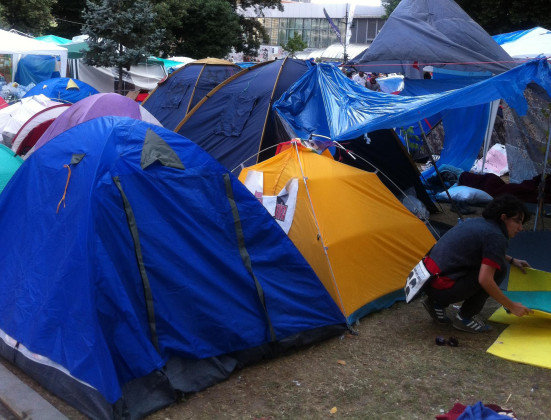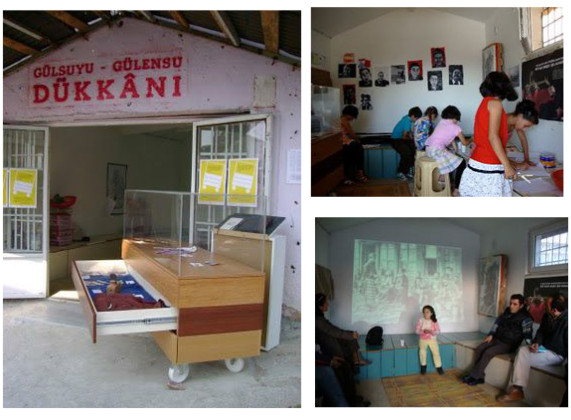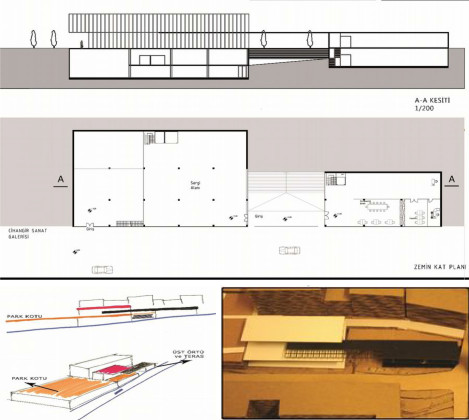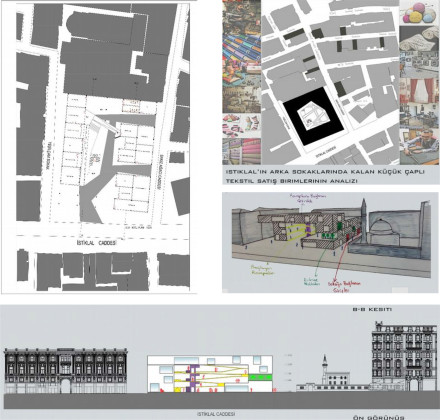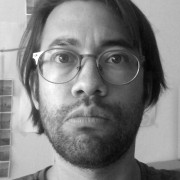Tactical Spatial Experiments in the Studio
The concept of “the cunning of the Orient”, frequently criticized for carrying an Orientalist perspective, has been the subject of many novels and films. Adapted from Aziz Nesin’s novel of the same name, Zübük (1980) tells the success story of a foxy protagonist; Zübük is a liar, and many hate him, but somehow he manages to rise through the ranks of politics. Nesin’s novel depicts the protagonist as a taleteller, a trickster, a deceiver, a hypocrite, a quick-witted man, and an embodiment of “the cunning of the Orient”. Throughout the novel, few other characters also demonstrate the potential of becoming Zübük. Zübük is the type of a protagonist we see and hear of in countless cases throughout our daily lives. He is an actor tailored by the present system; he is able to exist, and to partake, successfully within the system by his spontaneous actions and discourses.
Epic stories turn relations of power in reverse compared with the narrative of institutional power in historiography, and the weak in those stories avoid the realities of institutionalized order, and become the writers of history (Certeau, 2008). Certeau articulates the concepts “strategy” and “tactics” with examples such as withdrawal from work (“la perruque” in work) in the modern economic model, and as proverbs, mastery in rhetoric, and games in folk cultures. These arts of action of the everyday life invert the dynamic between the strong and the weak. Social movements borrow from this repertoire of actions, and further develop it by inventing new tactics.1
Against strategies formed through manipulations of power, how can the tactics of the weak urban dweller have an effect on spatial design, text or foresight in architectural design education? First step would be starting a discussion on the relations between space and actions in a bid to launch inquiries, as well as the search, for tactics in urban design studio—where strategies of the education system, together with the professional practice and power relations, prevail. From the spatial-deterministic point of view, if a repertoire of tactical actions exists, spatial formations that correspond to these actions should do so as well. The tactics, however, emerging in the striated spaces of power cannot be designed spontaneously. How could architecture, a practice that provides power, along with the ability to occupy space; and architectural design, a strategic practice, contribute to the formation of tactics?
Urban Space – Action - Tactics
Arendt refers to three aspects of human condition—labor, work, and action—and emphasizes the importance of action due to its status as a determinant of history in the form of the political act. To act is to take initiative, and to set things in motion (Arendt, 2000). The human generates herself in action and speech, and public space is possible with the cooperation of human in the revelation of action. Arendt defines public space as the space where reciprocal visibility exists. Thus, we may conclude that urban space is the place with a potential not only of freedom for cooperation and action, but also of the power for exposure.
In the contemporary urban space shaped by the neoliberal economy, regeneration of capital continuously creates unequal urban dwellers. These processes, executed by state institutions or by private investors, increase class polarization. Through this destruction, according to Harvey (1996), the only thing available for demand is “a greater democratic control over the production and use of the surplus”. Application and diffusion of this would constitute the right to the city. At this point, a collective reclamation of the right to the city in a global scale is of utmost importance, since it exerts pressure on the political power. In “The Right to the City”, Harvey defines the concept of right to the city as the freedom to make and remake our cities and ourselves. It is one of the most precious yet most neglected of our human rights; we abandon the right to change ourselves by changing the city.
Certeau uses strategy as the calculation (or manipulation) of power relationships that becomes possible as soon as a subject with will and power (a business, an army, a city, a scientific institution) is isolated. It postulates a place which can be defined as its own, which can serve as the base from which relations with an exteriority can be managed. A tactic, in contrast of a strategy, is the calculation determined by the absence of a proper locus. The space of tactic is the space of the other. Since tactic cannot capitalize gains, the absence of place provides it with mobility. Within the control of power, which possesses properties, tactic creates fractures; and it has to use these fractures in a precise and careful manner. Strategies, consequentially, put the relations of space forward, and tactics, acting on the presence of power, are by definition absent of space and power.
The “Other”, the weak that has to move within the limits determined by figures of power, has to find unobstructed routes inside the system. Certeau examines a large scale of examples from the use of language (proverbs, myths, stories, etc.) to spatial practices (basic act of walking in the city) while demonstrating the cases where the weak triumphs over the strong in plenty of quotidian practices. James C. Scott, anthropologist and political scientist, in his book Domination and the Arts of Resistance, refers to the presence of various sorts of resistance developed by the oppressed against the ruler. Scott claims that in the reciprocally acknowledged struggles between the powerful and the subordinate, a repertoire of actions—from going slow in work to backbiting—takes place in different places and times, serving as power-eroding tactics. Such a statement stands in parallel with Certeau’s claim on the repertoire of actions.
In a world of strategies produced by capitalist relations that diffuse even into the most private realms of everyday life, the plurality of spontaneous positioning and actions comes with the potential risk of tactics turning into strategies, and creating further new, unforeseen realms of tactics. In this vicious circle, it becomes more and more difficult to distinguish strategies from tactics. Yet it is obvious that architecture is on the side of strategies due of its characteristics determined by property and representation of permanence. The collaboration of global capital and power dominates the processes of design, construction and creativity in architecture. Our study explores the potential of architecture to develop tactics. We will initially focus on the practical works by various architectural and urban design collectives around the world, and in Turkey.
H-activist2: On the Potential of Tactic to Generate Space
In informatics, hacking is defined as abusing the vulnerabilities of the system by using its own tools and codes to redirect existent programs towards new purposes. Hacking is a way of generating tactics. It is possible to find similar actions that transgress systems in political, economic, social and urban realms of power. In 2013, we all witnessed such actions in the Gezi case. Dealing with Gezi, many essays focused on the creativity of sarcasm and irony of the discourse. The act of occupation made tactics politically and socially visible; and economic examples of spatial tactics emerged. Hacking urban space and occupation are political attitudes. By these actions, it is possible to steps outside the system, and with spontaneous solutions or problems, to create an unforeseen, emancipated radius of action. How can we sustain these spontaneous actions, especially in the education stages of a profession based on settlement?
In the realm of design, creative tactic experiments have been in practice since the 1960s. It should be noted that these tactical developments emerged as an extension of “participatory design”3—simultaneously with the theoretical avant-garde aiming to invade the entirety of life. An example of this is the squatting tradition, which rallied through the 1970s. In terms of the destitution of rights in times of housing crisis, squatting as a tactic was practiced as political and autonomous action in which disused houses were occupied without any permission, or a signed contract, with the property owner. It was illegal according to the state’s law on private property; however, it was an activist solution for need for shelter. Slums, which appeared overnight in the 1950s, are another example of the tactic space. Aside from the individual initiatives of urban dwellers such as these, some collectives also organize similar spatial formations.
Spatialagency state on their website that their projects are means of contemplating how an alternative architecture can come about. The same website sees many groups dealing with questions, researches, and projects of tactical spatial production since the 1960s. One of those groups is AAA (Autonomous Architecture Atelier), established in Paris in 2001 by Constantin Petcou and Doina Petrescu. The group carries out their interventionist urban projects through a dynamic collective platform with many partners, such as non-governmental organizations, academicians, artists, and neighbors. The platform uses tactics in order to get idle urban areas occupied by dwellers and to keep them active, and the group intends to develop participatory practices that empower grassroots movements for a more ecologic and democratic city. The ECObox project that was designed and implemented between the years of 2001 and 2005, in the La Chapelle district of Paris, was a temporary and mobile public garden built of recycled materials. The project re-functionalizes unused areas, and joins different life forms and living experiences together in order to conserve biodiversity. The collective has gradually become a cultural platform where urban critiques and creative projects are dealt with in a local scale and beyond. In 2005, for example, the Italian collective Stalker/Osservatorio Nomade executed the Paris part of their ViaEgnatia project, which spread from Paris to İstanbul, with installations and workshops in ECObox. The urban means of ECObox, such as mobile-kitchen, mobile-library etc., hosted discussions on migration, borders, cultural transference, and economical interaction with the neighbors’ cooperation.
AAA was in İstanbul in 2009 to share their experiences in Dükkan with the community of the neighborhood in Gülsuyu-Gülensu. The Dükkan Project, similar to ECObox, employed an urban tactic, and occupied an empty building in the neighborhood and transformed it into a dynamic and collective sharing space that held meetings, workshops, and film screenings, including certain programs such as children playground and an exhibition space. Many artists, activists, academicians and students delivered talks and workshops in the project. A mobile showcase and a library were built in front of Dükkan.
In tactical terms, production of design and of design space is a participatory urban action. In 2004, Dissident Architecture camp took place in Germany, where Roemer van Toorn of Berlage Institute, stated in his speech that critical architecture could not work with an outsider point of view. Thus, he claimed that resistance practices should be developed within the Empire (Hardt, M., Negri, A. 2012)4. Within “the Empire”, which Hardt and Negri defined as the presence of a transnational organ in the form of global hegemony, the outside does not exist; hence, new alternatives may only flourish from the actions of the multitude as an active majority. This claim supports Toorn’s remark. Tactic could only become a practice if architecture education leaves the physical space designed for it, and starts tracing and cooperating with the tactics of the urban dwellers developed against strategies. Our research and studio processes unfortunately lacked the participatory work, so the tactic-space studio could not come up with the alternative projects we had earlier hoped for.
On the Examples from Tactic Space Workshop/ Projects from Tactic Space Studio
The range of everyday tactics is so wide that Certeau, in order to define practices in tentative characterization, refers to the possibility of operational schemes and technical manipulation procedures. If we consider the concept “operational schemes” or “action schemes” in the case of Gezi Park, it starts as “camping”—a practice that can be traced back to The Right to the City movements of 1970s. Forums, workshops, barter faire, food feasts etc., which occurred during Gezi can be considered as collective production and action schemes.
What we intended to achieve in the tactic space studio was to reveal the actions. In spite of the richness of the action repertoire, in the present text we will only focus on only three design cases. We asked the studio participants to observe and review the tactical actions that they come across within the city or read about in the news, etc.; and then to study how these actions can be designed in spatial terms. The students proposed various topics on which presentations were later delivered. Strategy-based categorization in the projects included experiments on spatial organization of socio-spatial urban movements5, “places of memory” in social actions6, spatial organization of alternatives to the present economic system7 and spatial organization for re-functionalizing of the present built environment8.
Project 1
“Time Bank”9 is a critique of the economic capital imposed by the capitalist world. The project seeks to develop tactics for the white-collar workers who sell their time in exchange for money. The mass of white-collars are manipulated by the immediate relationship between the money economy of the globalizing city, and its space and time; so the social interaction decreases due to the logic of harder work and quicker production. The project put away money, the material currency of labor and information, and required the individuals to barter their experiences in definite time slots. The process started with an analysis of labor sectors, and Cihangir was chosen as the dwelling zone. Cihangir was suitable as a zone since the dwellers worked in a variety of sectors; and with Taksim and Kabataş nearby, transportation was easy. “Time Bank” was designed as a 24-hour, non-controlled space of activities consisting of workshops of various sizes. “Bank”, a basic element of the capitalist economy, was used ironically in the name of the project—itself a non-monetary exchange system.
Project 2
Within the consumer culture context, shopping malls swept away local production. The second project chose peddling and street marketing as its tactical actions. The proposal included a pedestrian street, called Textile Square, connected to İstiklal Street. The spatial organization of the marketplace took on the free movement characteristic of İstiklal Street, and provided the local artisans with a free marketing space. Dissolution of petty traders and low-income consumers was considered as the strategy of global economy on local level, as well as the throwaway culture and new consumption habits generated by global capital. With globalism’s impact on urban space, İstiklal Street has become the center of branding and consumption; and Demirören Shopping Mall is now a symbolic place in terms of the surplus value of space. The project, with a critical perspective towards the rent value, looks into the actions and spaces in Demirören’s estate, and proposes a light and open structure that connects the surrounding streets—where many shops of artisans and makers are recently being closing down due to gentrification. The functions of such shops are transferred to the project, and thus, the local petty traders, artisans, and traditional consuming patterns are supported.
Project 3
“Transversal Art Space” project is a critique of arts’ transformation into novel means of surplus value in global economy. The routes of contemporary art are dominantly determined by states and by companies (Stallabras, 2009). Art galleries, which organize and discipline the autonomy of art (Artun, 2011), together with chain museums that are now art-shops, have gotten ahead of art itself. The project attempts to imagine an art space where artists autonomously and independently produce their work and share it with their audience. The search for building plot around Taksim and Kabataş revealed that there was no place in the area, except private galleries, for making and exhibiting art. So the program was designed to position by the Gezi Park, with the aim of using the entirety of the park. An open-planned space organization was designed which included workshops and galleries, where artists do not have to pay rent; or be subordinated by art curators.
During the projects summarized above, we did not generate action procedure schemes. In the presentations, however, the domain of power was clearly defined. In this context, discussions focused on what strategy was, and what sort of tactics existed, and could exist in the future. Taking it from where the studio discussions left, it is very critical for us to set forth some action procedures. “Time Bank” project leaves room for a procedure stemming from work-withdrawal action in working hours. “Textile Square” project makes it possible for informal sector to peddle and escape. In “Transversal Art Space”, street art and street occupation possibilities have the opportunity to diffuse into Gezi Park, and to exist freely on the surfaces and spaces there.
Discussion
Urban spaces in globalization are shaped by the manipulations of power: Power is the network of relations that penetrates each and every aspect of daily life. The tactics urban dwellers develop in everyday life against the strategies power employs to sustain itself, were at the center of the discussion in our design studio. Marketing of urban space, gentrification, dispossession, and consumer culture are the urban problems emerging from ongoing cycles of capital and power in the global city. Spatial homogeneity and exclusion have negative effects on the everyday life of urban dwellers. For architecture education to fully understand the spatial transformation of tactics, it seems very important to identify and interpret problematic spatial practices, i.e. spatial, social, political, cultural, ethnic practices in urban scale.
Design is an action in which potentialities and utilization possibilities of the space are thoroughly examined. As an architect, one practices this action at her desk; as a student by her scenario and imagination; and as a professional, on the market through the interaction with the client. The outcomes of design processes always have unforeseen effects, deficiencies that do not correspond to spatial necessities, and various uses that were not initially designed. Aragon’s lines may properly be adapted: “There is no happy architecture.” Architecture education entails a one-way transfer, and does not establish contact with the user. It heads out for a marketable outcome. These characteristics of architecture education should further be looked into.
We started our studio process wondering how we could research tactics, and their transformation into space, and what they would become through an architecture studio course. “The Other” of urban life was discussed, and strategies and tactics were identified. The requirements of architecture education per semester—multi layered, programmed, spatially limited buildings—interrupted the path from discussions to spatial transformation. As the first level of an experimental study, the studio generated awareness on the right to the city, on resistance mechanisms, exclusion and such. Practicing spatial production inspired by quotidian tactics can also be studied as a method in the design studio in the future.
Bibliography
-Arendt, H. (2000). İnsanlık durumu. (B. S. Şener, Trans.). İstanbul: İletişim Yayınları. [Original title: The Human Condition]
-Artun, A. (2011). Çağdaş sanatın örgütlenmesi. İstanbul: İletişim Yayınları.
-Certeau, M. (2008). Gündelik hayatın keşfi-I. Ankara: Dost Kitabevi. [Original title: Practice of Everyday Life]
-Foucault, M. (1992). Hapishanenin doğuşu. İstanbul: İmge Kitapevi. [Original title: Discipline and Punish]
-Hardt, M., Negri, A. (2012). İmparatorluk. İstanbul: AyrıntıYayınları. [Original title: Empire]
-Harvey, D. (1996). Post modernliğin durumu. İstanbul: Metis Yayınları. [Original title: The Condition of Postmodernity]
-Keyder, Ç. (2006). İstanbul: Küresel ile yerel arasında. İstanbul: Metis Yayınları.
-Lefebvre,H. (2007). Modern dünyada gündelik hayat. İstanbul: Metis Yayınları. [Original title: Everyday Life in the Modern World]
-Scott, J. (1995). Tahakküm ve direniş sanatları. (A. Türker, Trans.). İstanbul: Ayrıntı Yayınları. [Original title: Domination and the Arts of Resistance: Hidden Transcripts]
-Stallabras, J. (2009). Sanat A.Ş.: Çağdaş sanat ve bienaller. (E. Soğancılar, Trans.). İstanbul: İletişim Yayınları [Original title: Art Incorporated: The Story of Contemporary Art]
Links
-www.sendika.org/2013/05/kent-hakki-david-harvey/, 20.4.2016
-www.maketools.com/articles-papers/Sanders2013Perspectives.pdf
-www.spatialagency.net/database, 20.4.2016
-www.spatialagency.net/database/why/political/aaa, 20.4.2016
-www.mimarlikdergisi.com/index.cfm?sayfa=mimarlik&DergiSayi=387&RecID=3242 , 20.4.2016
Notes
1 Certeau refers to Le Monde’s pages on bridge and chess where possibilities of turns and moves are enumerated and recorded in an action scheme repertoire. As studied in Propp’s works, tales and myths do the same.
2 The term is used in reference to the topic on the following page: www.urbangardensweb.com/2015/09/04/guerrilla-architecture-hacktivist-urban-housing/
3 Sanders, E. B.-N. (2013) Perspectives on Design in Participation. In Wer Gestaltet die Gestaltung? Praxis, Theorie und Geschichte des Partizipatorischen Designs, Mareis, C., Held, M. and Joost, G. (Hg.), Verlag.
4 http://v3.arkitera.com/v1/haberler/2004/07/26/berlinlampi.htm , 20.4.2016
5 The problems with strategies identified under this topic are urban evacuation, informal sector, consumer culture, art economy, violence to women, migration, destitution, social awareness, sexual discrimination and privatization of public space.
6 The spatial organization proposals in question are those aiming at revealing and archiving historical traces of ethnic, religious and cultural segregation, and cultural continuity.
7 Spatial organizations where money based capitalist economy is transformed.
8 Re-functionalization of built environment effected by urban transformation.
9 The projects were studies by the following students: “Time Bank” by Yağız Çekem; “Textile Square” by Atkut Akdeniz and “Transversal Art Space” by Mehmet Karabalık.
Related Content:
-
Fragments on Asemic Art and Architecture
We are living in the middle of a dilemma –the social media is a hungry monster, we endlessly feed its stomach with meaning, just to be digested in an instant. Instagram, which suggests this destiny by its name, works as a cycle of production and consumption that has to be broken. The meaning production itself is creating the meaninglessness of self.
-
10 Tips For A Successful Architectural Design Studio
Has architectural education become such a know-how package that is transmitted through such documents only?
-
Inhabiting the Earth in Symbiosis with the Environment
Aixopluc takes on the challenge to find new modes of inhabitation in symbiosis with planet earth
-
Design after Progress
Why is so much design still bad?
-
Is Creativity the Goal?
Architecture is a beautiful art, an art of creating spaces; it produces new works of art
 17.10.2016
17.10.2016



